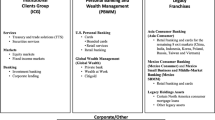Abstract
A model for organizational design of post corporation structure is developed in this paper. Alternative organization solutions have been designed taking into account the post environment characterized by private operators' competition and development of new message transmission technologies. Criteria for organizational design have been considered as numerical and uncertain linguistic variables describes by fuzzy sets. The model has been tested on a numerical example.
Similar content being viewed by others
References
Arrow, K.J. and R. Radner (1979), “Allocation of Resources in Large Teams,” Econometrica, 47, 361–385.
Barua, A. and A.B. Whinston (1998), “Decision Support for Managing Organizational Design Dynamics,” Decision Support Systems, 22, 45–48.
Baumol, W.J. and L. Fabian (1964), “Decomposition, Pricing for Decentralization and External Economics,” Management Science, 11, 1–32.
Burton, R.M. and B. Obel (1977), “The Multilevel Approach to Organizational Issues of the Firm—A Critical Review,” OMEGA, 5, 395–414.
Burton, R.M. and B. Obel (1995), “Mathematical Contingency Modelling for Organizational Design: Taking Stock,” in Borge Obel and Richard Burton (Eds), Design Models for Hierarchical Organizations. Computation, Information and Decentralization. Kluwer Academic Press Publishers, Massachusetts.
Burton, R.M. and B. Obel (1996). Strategic Organizational Diagnosis and Design, Cluwer Academic Publishers.
Carley, K.M. and Z. Lin (1995), “Organizational Designs Suited to High Performance Under Stress,” IEEE Transactions on Systems, Man and Cybernetics, SMC-25(2), 221–230.
Carley K.M. (1995), “Computational and Mathematical Organization Theory: Perspective and Directions,” Computational and Mathematical Organization Theory, 1, 39–56.
Carley, K.M. (1996), “A Comparison of Artificial and Human Organizations,” Journal of Economic Behavior and Organization, 31, 175–191.
Carroll, T. and R.M. Burton (2000), “Organizations and Complexity: Searching for the Edge of Chaos,” Computational and Mathematical Organization Theory, 6, 319–337.
Dantzig, G. and P. Wolfe (1961), “The Decomposition Principle for Linear Programming,” Econometrica, 29, 767–778.
Dubois, D. and H. Prade (1978), “Operations on Fuzzy Numbers,” International Journal of Systems Science, 9, 613–626.
Dubois, D. and H. Prade (1987), “Fuzzy Numbers: An Overview,” Analysis of Fuzzy Information, 1, 3–39 CRC Press, Boca Raton.
Eckenrode, R.T. (1961), “Weighting Multiple Criteria,” Management Science, 12, 180–192.
Galbraith, J.R. (1977). Organization Design, Addison—Wesley Publishing Company.
Hyatt, A., N. Contractor and P. Jones (1997), “Computational Organizational Network Modeling: Strategies and an Example,” Computational and Mathematical Organizations Theory, 3(4), 285–300.
Hwang, C.L. and K. Yoon (1981). Multiple Attribute Decision Making—Methods and Applications, Springer, New York.
Jehiel, P. (1999), “Information Aggregation and Communication in Organizations,” Management Science, 45(5), 659–699.
Jin, Y. and R. E. Levitt (1996), “The Virtual Design Team: A Computational Model of Project Organizations,” Computational and Mathematical Organization Theory, 2(3), 171–196.
Joslyn, C. (1994), Possibilistic Processes for Complex Systems Modeling, PhD Dissertation, SUNY—Binghamton, Systems Science.
Joslyn, C. and L. Rocha (2000), “Towards Semiotic Agent—Based Models of Socio—Technical Organizations,” Proceedings AI, Simulation and Planing in High Autonomy Systems, ed HS Sarjoughian et al.
Kapasouris, P., D. Serfaty, J.C. Deckert, J.G. Wohl and K.R. Pattipati (1991), “Resource Allocation and Performance Evalution in Large Human—Machine Organizations,” IEEE Transactions on System, Man and Cybernetics, SMC-21(3), 521–532.
Kauffman, S. (1993). Origins of Order, New York: Oxford University Press.
Klir, G. and T. Folger (1987). Fuzzy Sets, Uncertainty and Information, Prentice Hall.
Kosko, B. (1990), “Fuzziness vs. Probability,” International Journal of General Systems, 17 (2/3), 211–240.
Kosko, B. (1990). Neural Networks and Fuzzy Systems, Prentice—Hall, Englewood Cliffs, NJ.
Lawrence, P.R. and J.W. Lorsch (1967). Organization and Environment: Managing Differentiation and Integration. Boston: Graduate School of Business Administration, Harvard University.
Levitt, R.E., J. Thomsen, T.R. Christiansen, J.C. Kunz, Y. Jin and C. Nass (1999), “Simulating Project Work Process and Organizations: Toward a Micro—Contingency Theory of Organizational Design,” Management Science, 45(11), 1479–1495.
March, J. and H. Simon, (1958). Organizations. New York, NY: Wiley.
Newell, A. and H. A. Simon (1972). Human Problem Solving, Englewood Cliffs, NY: Prentice Hall.
Papastavrou, J.D. and M. Athans (1992), “On Optimal Distributed Decision Architectures in a Hypothesis Testing Environment,” IEEE Transactions on Automatic Control, AC-37(8), 1154–1169.
Perdu, D.M. and A.H. Levis (1998), “Adaption as a Morphing Process: A Methodology for the Design and Evaluation of Adaptive Organizational Structures,” Computational and Mathematical Organizational Theory, 4(1), 5–41.
Pete, A., K.R. Pattipati and D.L. Kleinman (1993), “Distributed Detection in Teams with Partial Information: A Normative—Descriptive Modal,” IEEE Transactions on System, Man and Cybernetics, SMC-23(6), 1626–1648.
Pete, A., K.R. Pattipati and D.L. Kleinman (1994), “Optimization of Detection Networks with Multiple Event Structures,” IEEE Transactions on Automatic Control, AC-39(8), 1702–1707.
Pete, A., K.R. Pattipati and D.L. Kleinman (1995), “Structural Reconfiguration and Informal Coordination in Administrative Organizations,” Computational and Mathematical Organization Theory, 1(1), 93–116.
Pete, A., K.R. Pattipati and D.L. Kleinman (1996), “Optimization of Decision Networks in Structured Task Environments,” IEEE Transactions on Systems, Man and Cybernetics—Part A: Systems and Humans, SMC-26(6), 739–748.
Pete, A., K.R. Pattipati and D.L. Kleinman (1998), “An Overview of Decision Networks and Organizations,” IEEE Transactions on Systems, Man and Cybernetics—Part C: Applications and Reviews, SMC-28(2), 173–193.
Petrović, S. and R. Petrović (1998), “Fuzzy Multicriteria Methodology (FMM),”—Decision Support Software.
Petrović, S. and R. Petrović (1999) “A New Fuzzy Multicriteria Methodology for Ranking Alternatives,” Proceedings of XV World Conference on Operational Research, IFORS 99, Beijing, P.R. China, August 16–20, pp. 117.
So, Y. and E.H. Durfee (1996), “Designing Tree—Stuctured Organizations for Computational Agents,” Computational and Mathematical Organization Theory, 2(3), 219–246.
Tang, Z.B., K.R. Pattipati and D.L. Kleinman (1993), “Optimization of Detection Networks: Part II—Tree Structures,” IEEE Transactions on System, Man and Cybernetics, SMC-23 (1), 211–221.
Zadeh, L.A. (1965), “Fuzzy sets,” Information and Control, 8, 338–353.
Zaidi, A.K. and A.H. Levis (1997), “Validation and Verification of Decision Making Rules,” Automatica, 33(2), 155–169.
Author information
Authors and Affiliations
Rights and permissions
About this article
Cite this article
Kujačić, M., Bojović, N.J. Organizational Design of Post Corporation Structure Using Fuzzy Multicriteria Decision Making. Computational & Mathematical Organization Theory 9, 5–18 (2003). https://doi.org/10.1023/B:CMOT.0000012306.85541.8d
Issue Date:
DOI: https://doi.org/10.1023/B:CMOT.0000012306.85541.8d




